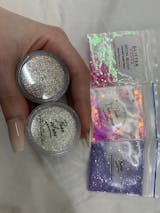
Glastonbury Festival, held every year in the English countryside, is one of the biggest outdoor music festivals in the world. Acts come from across the world and from all parts of the music and arts spectrum. Glastonbury is therefore a trendsetter in a number of ways - innovations first seen at Glastonbury have gone on to become standard practice for music festivals around the world.
So, when Glastonbury announced that they were cutting back on plastic at the site by eliminating single-use plastic and only allowing biodegradable glitter, it was a warning signal to a number of businesses. Festival organisers and the businesses that maintain a presence at music festivals now understand better than most that eco-friendly products can command a higher price tag.
However, perhaps inevitably, there has been a rise in businesses trying to pass off their products as being ‘biodegradable’ or ‘eco-friendly’ when they are not.
Glitter Haven are proud to work with businesses like Bio-Glitter, who provide genuine biodegradable glitter. Unfortunately, the Australian market is awash with supposedly green products that are actually anything but.
Greenwashing
Greenwashing is a process that harms everybody. Not only do businesses think that they are contributing towards an environmentally-friendly product, they will then use the product under the assumption that it biodegrades. If this is not actually the case, users will scatter the glitter in places they otherwise wouldn’t, wholly unaware of the damage they are causing.
‘Biodegradable’
Part of the reason that businesses are able to get away with palming off their glitter as biodegradable is because of confusion over what the term 'biodegradable’ actually means. A product that is biodegradable may take hundreds of years to biodegrade, or require quite specific conditions.
In the case of these glitters, businesses are able to sell them as biodegradable in Australia if they contain a certain percentage of material that can be composted, and which have ‘cellulose’ (referring to early 1930s cellulose technology) in the name.
Common examples include cellulose acetate and cellophane. These products are technically biodegradable, but they won’t degrade naturally if they are just left outside on the floor - which is what most people assume.
Going Green
Fortunately, we at Glitter Haven source our biodegradable glitter from a reputable supplier (Bio-glitter in case you are wondering). It is encouraging that there is now an awareness of the importance of biodegradable glitter and so many people looking to buy it.
However, it is important that consumers are careful. Remember, just because it says it is biodegradable, that doesn’t necessarily mean it’s eco-friendly. If you want to be safe - check out our environmentally-friendly biodegradable glitter.






